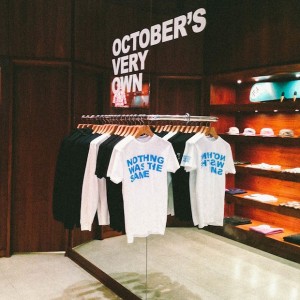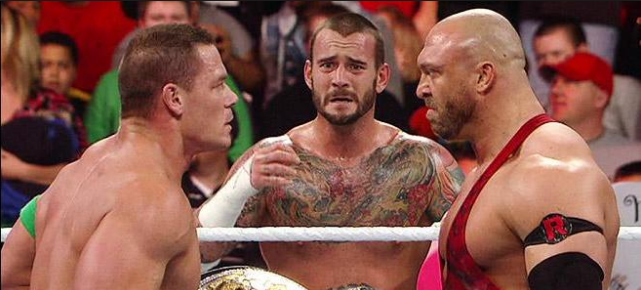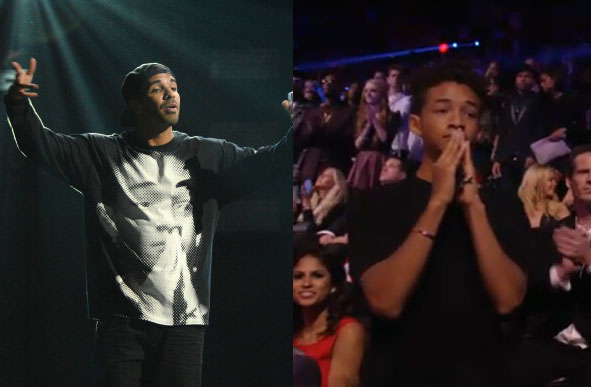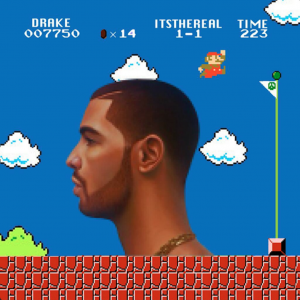
We were going to photoshop Batman into this or something, but I’m pretty sure someone on Tumblr has beaten us to it.
There’s probably not an artist in pop music more divisive than Aubrey “Drake” Graham. No one is really lukewarm on his music. You either hear “I dig Drake” or “I FUCKING DESPISE THAT DUDE.” As with a lot of post-Kanye rap artists, the average hip hop purist doesn’t have time for glittery introspection and humblebrags about Eames chairs and white wine. There’s an irascible predilection towards picking apart his every line, every cadence, every questionable fashion choice, every inopportune photo of him hugging someone’s aunt. In a landscape where one’s haters are one’s motivators, Drake wants for nothing in the muse category. After two hit albums, one a shaky, less than confident debut that leaned entirely too heavily on guest features and the careful curation of popular sonic trends, and another that effectively bent the zeitgeist to his dimly lit will, Drake has been poised all summer to drop his definitive opus.
Chief rival/Croissant Gawd Kanye West abdicated his claim to the throne by sidestepping the heavy expectations of his career best My Beautiful Dark Twisted Fantasy with the confounding Yeezus, choosing to dutch rudder the critics and appease pop prognosticators. Aging Highfather Hova sold out and/or bought into that sweet, sweet Samsung cash with Magna Carta Holy Shit This Is A Lazy Excuse For A Studio Album. Every interview and soundbite surrounding Drake’s gestating Nothing Was The Same positioned Drake as a prince waiting to be crowned. This was to be the LP that would finally silence his greatest detractors and leave every naysayer eating seared crow served on a bed of white rice with a hoisin sauce.
Alas.
It turns out that, despite his aggressive pandering to the elitist rap nerds he once wistfully considered his compatriots, Drake just can’t stop being Drake long enough to convert his opposition. If Take Care didn’t change your mind about Aubrey, with its ornate cohesion and undeniable string of singles, Nothing Was The Same will probably just annoy you. It’s like after the pointed nostalgia of sophomore album closer “The Ride,” Drake had fully raked away any of his dulcet, Instagram filtered, emotion foliage and thought, not unlike Black Sheep on the hilarious intro to A Wolf In Sheep’s Clothing, “I had a dream I was HARD.” Every subsequent guest verse and promotional single reintroduced us to an ill-shaven, curiously bicep’d Bro Monster who wasn’t going to take the endless trouncing he had become accustomed to receiving sitting down.
That is not to say that Drake abandons all emotional expression on this album. Quite the contrary, his pores continue to secrete 100 proof FEELZ, but this time, the shots come with no chaser. He, along with longtime BFF/co-conspirator Noah “40” Shebib, has crafted a rough and jagged new incarnation of their trademark OVO sound. The drums hit harder. The empty space between the synths feels less lived in, like a waiting room with no magazines. There’s a murky and jarring sense of nihilism running beneath many of the instrumentals. If there was a rap album version of the Bechdel test, this album would most likely fail, with it’s casually dismissive depictions of women and Neckbeard Nice Guy misogyny. Where his first album had him prematurely complaining about burgeoning fame and his second saw him navigating his ascent to the A-list, this album finds a more fully formed Drake whose confidence is no longer a shield, but a pointed dagger. He’ll never pack the punch beefier, bully rappers like Pusha T possess, but he spews verbal missives like arrow tips dipped in vitriol and condescension.
The album opens with hook-less “BARS”-fest “Tuscan Leather,” a blatant plea for lyrical credibility that flips the same Whitney Houston sample three different ways. “Flip” is sort of a stretch, because 40 really just makes three different beats that happen to have sped up Whitney vocals in the background. He can be forgiven, as chipmunk soul has never been his strong suit. Drake and 40 both sound meatier from the outset. 40’s long played Ricky Morton on Drake’s previous outings, handling the lion’s share of the shallower, more moody album cuts, killing time until Boi-1da shows up with the Robert Gibson hot tag bangers. Here, he’s got his weight up and has really expanded his musical horizons, each of his many contributions running the gamut in terms of tone and texture. “Furthest Thing,” with it’s late night confessional feel, wouldn’t have been out of place on Take Care. Midway through the song, severely underrated producer Jake One comes through with a huge save, providing the triumphant, soul-sample victory lap Just Blaze supplied on the last album’s “Lord Knows.” Blaze was most likely too busy playing ColecoVision with Baauer to be bothered to make an appearance, and this sort of outsize, Throne music is really what’s missing from Nothing Was The Same. Take Care was able to take place largely in an empty, late night diner full of regret and longing because the album’s powerhouse second act was built on muscular, radio ready club songs that were just left of center enough to feel authentic. Alas, T-Minus, the producer responsible for those poppy excursions, has allegedly retired.
In his stead, we get new OVO signee Mike Zombie’s thrilling but repetitive anthem, “Started From The Bottom,” which is the closest audio approximation of “fuck you” flip-flops Drake has ever slipped his feet into. His flows have matured to the point that his questionable boasts land with less awkward thuds. Rather than make a densely plotted concept album to compete with Kendrick Lamar or craft a larger than life persona to usurp Kanye or Jay, Drake has driven further down his own lane and is defiantly stating that this is where the action is. The fact that the album has so few guest features and almost no random appearances from super-producers is a testament to his dedication to crafting a cohesive, lasting body of songs. “Started From The Bottom” flows effortlessly into “Wu Tang Forever” which moves right into “Own It.” On an older album, these last two tracks may have been one, but here, each half is given room to breathe.
“Wu Tang Forever” is a song that samples Wu-Tang Clan’s “It’s Yourz” to ruminate on his relationship with both his fans and his erstwhile lovers, because of course it is. The song may not exemplify what the Wu stands for but the song isn’t concerned with paying homage to the dusty samples RZA employed in the early 90s so much as re-purposing the broad strokes of what the Wu was capable of. Outside of razor sharp street rhymes and unironic kung fu allusions, the Wu were capable of emoting sincerely and still maintaining credibility as “hard” rappers. You know, Drake’s entire thing in a nutshell. There’s no rational reason to title the song such other than to be a transparent “Fuck You” to the people who want him to change. The track’s epilogue, “Own It” is deliciously hypnotic and, as the production credits tell, “composed” by Detail, the man who gave the world Lil Wayne’s “How To Love.” The Wu references on this album are as plentiful as they are borderline hilarious. On “Tuscan Leather” he makes the claim, “I sip the Bora and listen to Cappadonna” which is humorous because even Cappadonna doesn’t listen to Cappadonna. His boasts in general evolve to a strange plateau. On “Worst Behaviour” he muses about his tennis playing hobby, bragging, “I swear I could be Serena, when she playing with her left.” If these lines are meant to be taken ironically, Aubrey has reached Tommy Wiseau levels of advanced hilarity.
“Worst Behaviour!” Can we talk about this song? Can we talk about how it sounds like Drake and his cohorts are hopping around menacingly without shirts on in a bathroom, like in a Chief Keef video? Can we talk about how I spent the first two minutes of the track thinking it was him aiming pointed swears and guttural backlash in the direction of his absent father? Can we talk about how the song reaches it’s abstract, ranting, apex and then, for almost no reason at all, Drake decides to bite one of the most recognizable Ma$e verses of all time to passive-aggressively stunt on his haters? Can we talk about how DJ Dahi, who famously produced Kendrick Lamar’s “Money Trees” laces the album with it’s most striking, visceral beat? It’s a gutsy volley that, coupled with #simptember theme song “From Time” perfectly sets us up for “Hold On, We’re Going Home,” the syrupy, soaring single that defies you not to warble along, regardless of your aptitude for falsettos and half-time choruses.
“Hold On…” calls back to the Tevin Campbell by way of 808s & Heartbreak ballad “Find Your Love” from Drake’s debut, a song that eschews any rapperly aspirations in lieu of cutting directly to the heart, or the throat, where sap averse listeners may find regurgitated bile frothing up. There’s an irresistible sweetness to the song that is impossible to escape. Frequent Kanye collaborator Hudson Mohawke contributes to the slinky “Connect,” a Night Bus slow burner that plays as a great counterpoint to Kendrick Lamar’s “Sherane AKA Master Splinter’s Daughter.” Whereas Kendrick uses the simple premise of a late night pussy run as a seedy prologue to a larger narrative, the thrill and unusual melancholy of the chase is enough for Drake. It’s exciting to hear HudMo’s production on a Drake album. His contributions to Yeezus were crowded, filled in tapestries, not unlike an overstuffed double page spread from George Perez, but in the OVO landscape, his unadorned instrumentation is given ample room to vent and stew.
Drake rounds out the album with an excellent trilogy of songs. “The Language” slows down the infectious flow he appropriated on the Migos hit “Versace” to deliver a litany of hashtaggably pithy rejoinders, using a stuntastic Birdman outro to bridge into “305 To My City,” an anti-matter universe “Fancy” that would have been used to great effect as the soundtrack to a slow-mo car chase in Michael Mann’s 2006 adaptation of Miami Vice. SBTRKT collaborator Sampha shows up on album highlight “Too Much” that is far and away and the best song on the LP. The pained vocals on the hook with the wilting, sped up sample ride a delightful bounce and some of Drake’s most assured introspection yet.
Album closer “Pound Cake/Paris Morton Music 2” is a bit of a mixed bag. The first half is marred by a questionable interpolation of “C.R.E.A.M.” done by Timbaland with his cloying beatboxer voice and two cast off verses from Jay-Z, the only other rapper featured on the album. The song’s second half reads like a self-satisfied Grammy speech Drake doesn’t seem to think he’ll get to deliver next year. The self-mythologizing and casual confidence he exudes situates him as our generation’s Jay-Z, theoretically going head to head against Kendrick Lamar’s Nas (who thankfully has usurped J. Cole in this particular pop culture dialogue.) Both he and Mr. Carter chose the “if not me, then who?” route of kingly coronation, and both are so relentlessly self aware and obsessed with being the ace of hip hop that it isn’t surprising Drake brought the Roc star out, even if on wax they display the inconsistent chemistry of Hiroshi Tanahashi and Kazuchika Okada going through the motions in the Tokyo Dome.
WARNING: SHAMELESS, REACHING WRESTLING ANALOGIES AHEAD
Speaking of confusing wrestling metaphors, I have finally found the perfect analogy for Drake’s place in the hip hop landscape. He is the John Cena of rap, right now. If you don’t know who John Cena is, he is essentially Generation Y’s answer to Hulk Hogan. He’s a professional wrestler who has been on the top of the WWE foodchain for the last ten years. He’s starred in abysmal movies, set world records for visiting Make-A-Wish kids, and held the world title more times than anyone else in the modern era. He is the face of professional wrestling, to the majority of the mainstream audience. He’s squeaky clean, preternaturally charming, and he possesses one of the most sincere forms of charisma. Naturally, jaded wrestling fans hate his guts. Wrestlers are supposed to be tough and jagged and vulgar. John Cena wears loud, primary colors and spews motivational claptrap that makes Hogan’s “say your prayers and eat your vitamins” diatribe sound like an epithet-filled dressing down from Glengarry Glen Ross. He’s saccharine, milquetoast and way too soft for people’s tastes. Fans have been begging for his on screen character to turn “heel,” or become a bad guy. Heisenberg-like transformations in pro wrestling are not out of the ordinary and are in fact the best way to revitalize a stale character, but they’re rarely done with wrestlers who sell as much merchandise as Cena clears annually. What Cena does to stay relevant is play to his opposition as much as he does his fanbase.
When Legit Movie Star/Wrestling Legend The Rock, calling Cena out for his colorful wardrobe and pandering to children, took to referring to Cena as “Fruity Pebbles,” he took it as an opportunity to begin appearing on the cereal box of the same name. When he arrives in the ring to a 50/50 chant of assorted “Let’s Go Cena”s nearly being drowned out by “Cena Sucks” he embraces it, and hams up the annoying side of his persona to further irk those who have long since tired of seeing him. The solution for him isn’t to change his character. It’s to play up the side of his character that works for each diametrically opposed half of his audience. He doesn’t have to turn heel, because for the fans that hate his guts, he already is one.
Likewise, Drake doesn’t need to rough up his exterior. People who hate him and his music enjoy doing so almost as much as those who genuinely revel in his output. Like, Cena, he’s turned himself into the ultimate troll. He’s able to maintain relevance not just by delivering consistent music to his fans, but by keeping himself an easy target for meme culture. No other rap artist has been so relentlessly Photoshopped, contorted and ridiculed to the degree that Drake has, and being the student of the game he is, this is largely by design. This year at the MTV Video Music Awards, one heavily gif’d moment was Jaden (son of Will) Smith’s exuberant reaction face to Drake performing. The young star appeared as though the Holy Ghost itself was surging through him, before composing himself into a quiet moment of what looked to be prayer. This weekend, at the iHeartRadio Music Festival, Drake arrived and performed in a sweater with Jaden Smith’s face emblazoned on his chest.
That is a man who has figured out exactly what it takes to get to the top of rap game and stay there. Drake, with his child actor background and safe profile, is like Will Smith in reverse. He shouldn’t, by all standards, be the star he is today. That he’s been able to shift the culture in his direction and do so by emphatically remaining true to himself is a remarkable feat, regardless of how funny it is to see his face Photoshopped into a level of Super Mario Bros.
Nothing Was The Same is available everywhere music can possibly be purchased.







One thought on “Leaving Houstatlantavegas: An In-Depth Look at Drake’s “Nothing Was The Same””